International Trade Finance and Investment
VerifiedAdded on 2023/01/05
|17
|5006
|4
AI Summary
This report discusses the concepts of international trade, finance, and investment. It explores how financial markets work for allocating capital within domestic and international economies. It also critically evaluates the key challenges faced by the UK due to industrialization and trade policies.
Contribute Materials
Your contribution can guide someone’s learning journey. Share your
documents today.
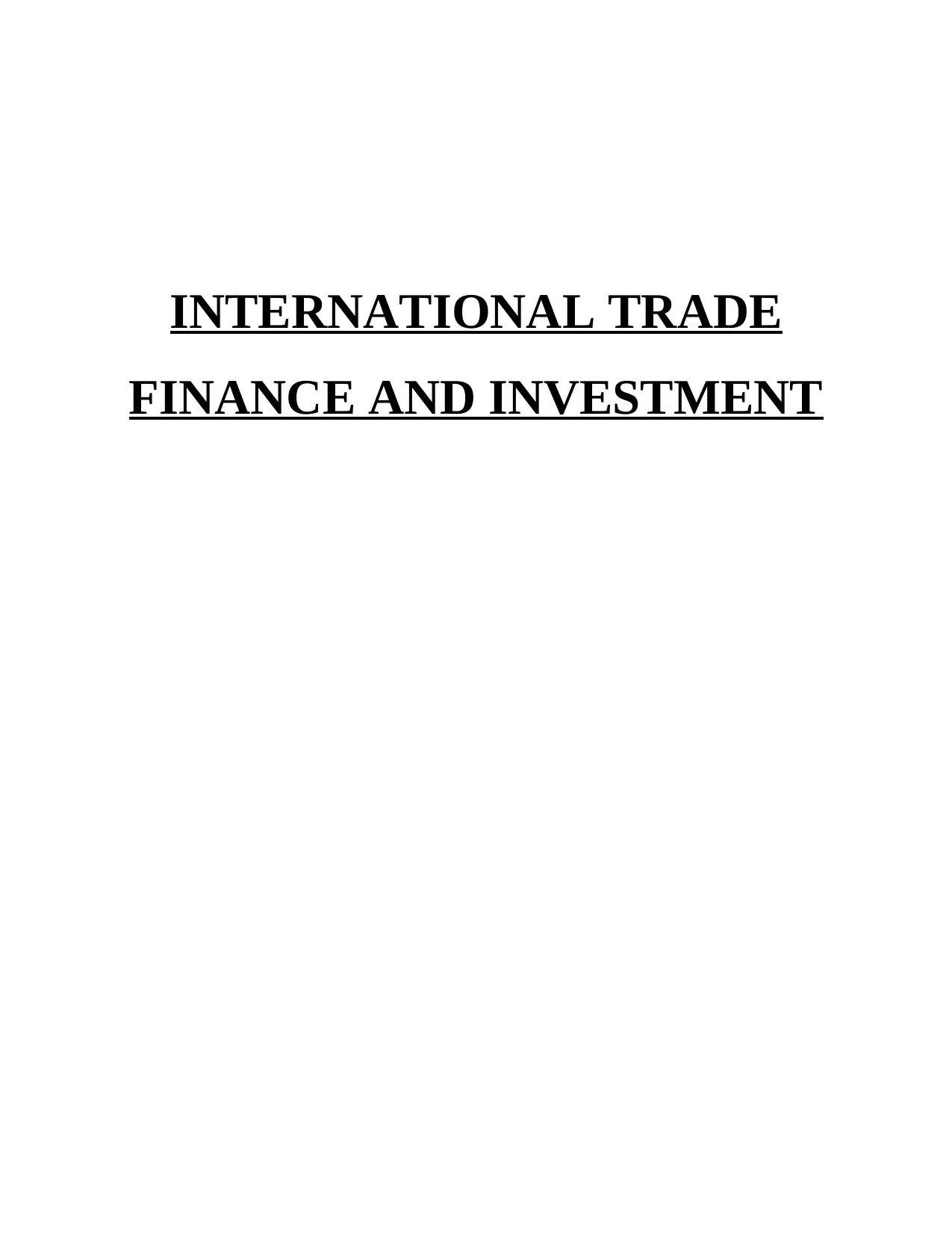
INTERNATIONAL TRADE
FINANCE AND INVESTMENT
FINANCE AND INVESTMENT
Secure Best Marks with AI Grader
Need help grading? Try our AI Grader for instant feedback on your assignments.
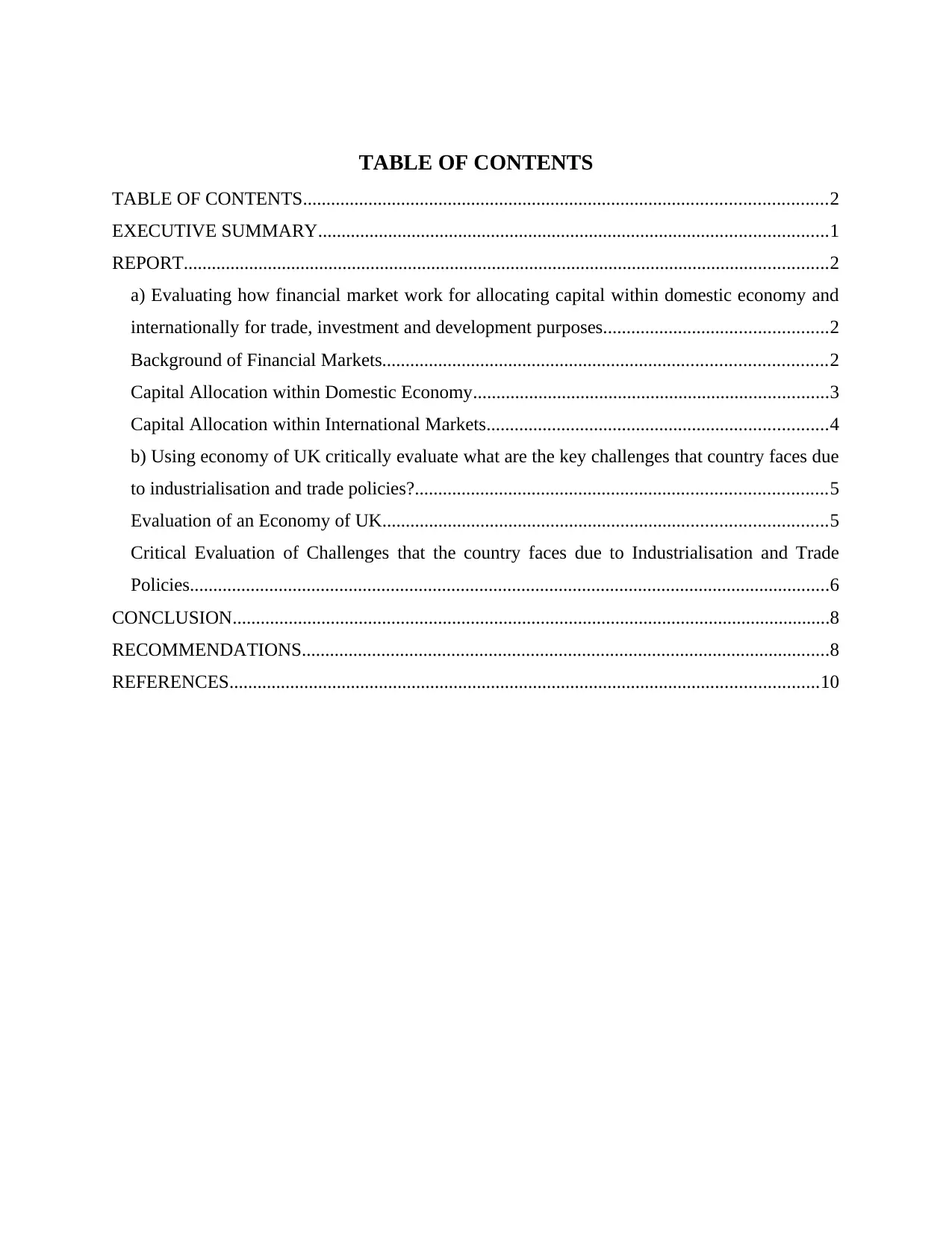
TABLE OF CONTENTS
TABLE OF CONTENTS................................................................................................................2
EXECUTIVE SUMMARY.............................................................................................................1
REPORT..........................................................................................................................................2
a) Evaluating how financial market work for allocating capital within domestic economy and
internationally for trade, investment and development purposes................................................2
Background of Financial Markets...............................................................................................2
Capital Allocation within Domestic Economy............................................................................3
Capital Allocation within International Markets.........................................................................4
b) Using economy of UK critically evaluate what are the key challenges that country faces due
to industrialisation and trade policies?........................................................................................5
Evaluation of an Economy of UK...............................................................................................5
Critical Evaluation of Challenges that the country faces due to Industrialisation and Trade
Policies.........................................................................................................................................6
CONCLUSION................................................................................................................................8
RECOMMENDATIONS.................................................................................................................8
REFERENCES..............................................................................................................................10
TABLE OF CONTENTS................................................................................................................2
EXECUTIVE SUMMARY.............................................................................................................1
REPORT..........................................................................................................................................2
a) Evaluating how financial market work for allocating capital within domestic economy and
internationally for trade, investment and development purposes................................................2
Background of Financial Markets...............................................................................................2
Capital Allocation within Domestic Economy............................................................................3
Capital Allocation within International Markets.........................................................................4
b) Using economy of UK critically evaluate what are the key challenges that country faces due
to industrialisation and trade policies?........................................................................................5
Evaluation of an Economy of UK...............................................................................................5
Critical Evaluation of Challenges that the country faces due to Industrialisation and Trade
Policies.........................................................................................................................................6
CONCLUSION................................................................................................................................8
RECOMMENDATIONS.................................................................................................................8
REFERENCES..............................................................................................................................10
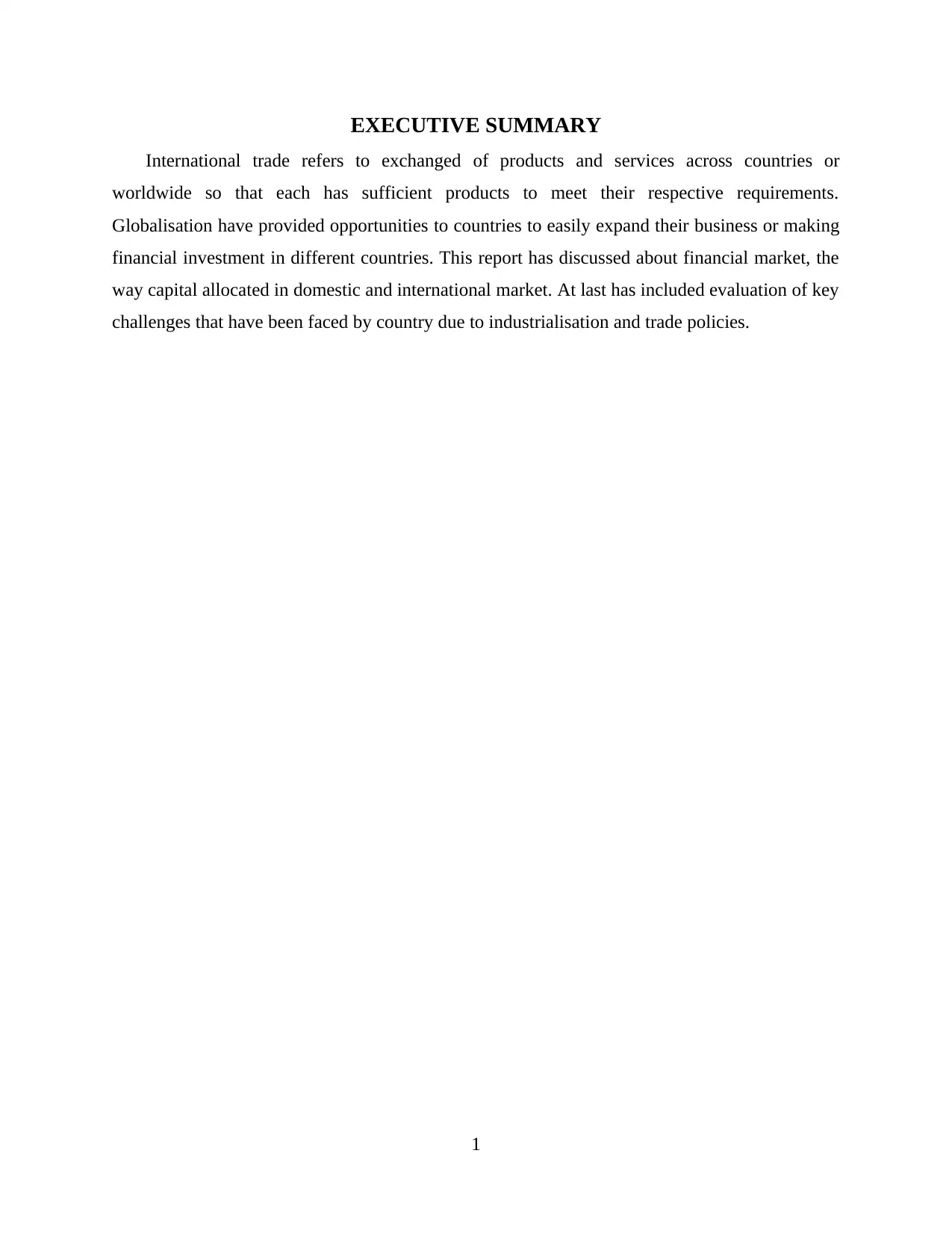
EXECUTIVE SUMMARY
International trade refers to exchanged of products and services across countries or
worldwide so that each has sufficient products to meet their respective requirements.
Globalisation have provided opportunities to countries to easily expand their business or making
financial investment in different countries. This report has discussed about financial market, the
way capital allocated in domestic and international market. At last has included evaluation of key
challenges that have been faced by country due to industrialisation and trade policies.
1
International trade refers to exchanged of products and services across countries or
worldwide so that each has sufficient products to meet their respective requirements.
Globalisation have provided opportunities to countries to easily expand their business or making
financial investment in different countries. This report has discussed about financial market, the
way capital allocated in domestic and international market. At last has included evaluation of key
challenges that have been faced by country due to industrialisation and trade policies.
1
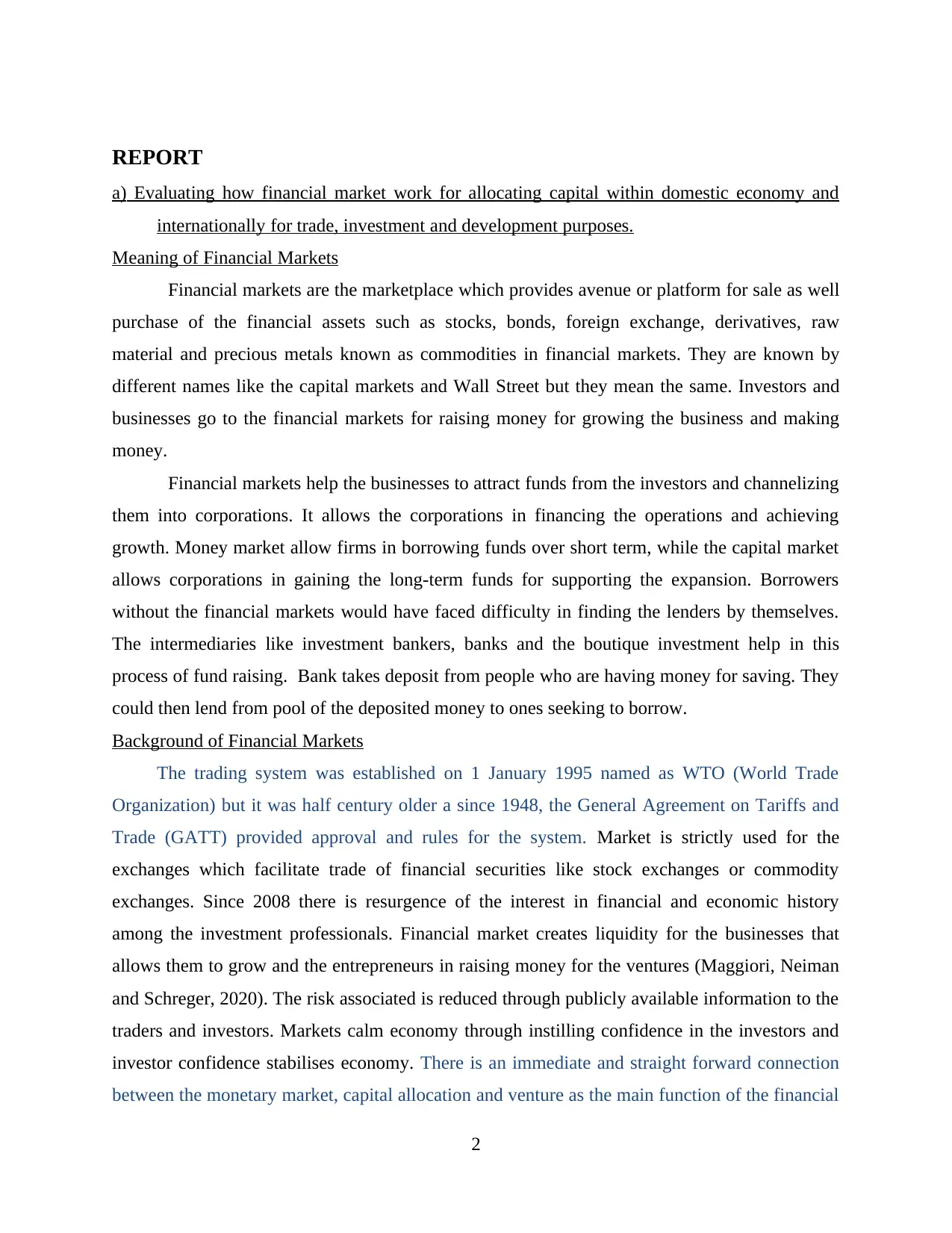
REPORT
a) Evaluating how financial market work for allocating capital within domestic economy and
internationally for trade, investment and development purposes.
Meaning of Financial Markets
Financial markets are the marketplace which provides avenue or platform for sale as well
purchase of the financial assets such as stocks, bonds, foreign exchange, derivatives, raw
material and precious metals known as commodities in financial markets. They are known by
different names like the capital markets and Wall Street but they mean the same. Investors and
businesses go to the financial markets for raising money for growing the business and making
money.
Financial markets help the businesses to attract funds from the investors and channelizing
them into corporations. It allows the corporations in financing the operations and achieving
growth. Money market allow firms in borrowing funds over short term, while the capital market
allows corporations in gaining the long-term funds for supporting the expansion. Borrowers
without the financial markets would have faced difficulty in finding the lenders by themselves.
The intermediaries like investment bankers, banks and the boutique investment help in this
process of fund raising. Bank takes deposit from people who are having money for saving. They
could then lend from pool of the deposited money to ones seeking to borrow.
Background of Financial Markets
The trading system was established on 1 January 1995 named as WTO (World Trade
Organization) but it was half century older a since 1948, the General Agreement on Tariffs and
Trade (GATT) provided approval and rules for the system. Market is strictly used for the
exchanges which facilitate trade of financial securities like stock exchanges or commodity
exchanges. Since 2008 there is resurgence of the interest in financial and economic history
among the investment professionals. Financial market creates liquidity for the businesses that
allows them to grow and the entrepreneurs in raising money for the ventures (Maggiori, Neiman
and Schreger, 2020). The risk associated is reduced through publicly available information to the
traders and investors. Markets calm economy through instilling confidence in the investors and
investor confidence stabilises economy. There is an immediate and straight forward connection
between the monetary market, capital allocation and venture as the main function of the financial
2
a) Evaluating how financial market work for allocating capital within domestic economy and
internationally for trade, investment and development purposes.
Meaning of Financial Markets
Financial markets are the marketplace which provides avenue or platform for sale as well
purchase of the financial assets such as stocks, bonds, foreign exchange, derivatives, raw
material and precious metals known as commodities in financial markets. They are known by
different names like the capital markets and Wall Street but they mean the same. Investors and
businesses go to the financial markets for raising money for growing the business and making
money.
Financial markets help the businesses to attract funds from the investors and channelizing
them into corporations. It allows the corporations in financing the operations and achieving
growth. Money market allow firms in borrowing funds over short term, while the capital market
allows corporations in gaining the long-term funds for supporting the expansion. Borrowers
without the financial markets would have faced difficulty in finding the lenders by themselves.
The intermediaries like investment bankers, banks and the boutique investment help in this
process of fund raising. Bank takes deposit from people who are having money for saving. They
could then lend from pool of the deposited money to ones seeking to borrow.
Background of Financial Markets
The trading system was established on 1 January 1995 named as WTO (World Trade
Organization) but it was half century older a since 1948, the General Agreement on Tariffs and
Trade (GATT) provided approval and rules for the system. Market is strictly used for the
exchanges which facilitate trade of financial securities like stock exchanges or commodity
exchanges. Since 2008 there is resurgence of the interest in financial and economic history
among the investment professionals. Financial market creates liquidity for the businesses that
allows them to grow and the entrepreneurs in raising money for the ventures (Maggiori, Neiman
and Schreger, 2020). The risk associated is reduced through publicly available information to the
traders and investors. Markets calm economy through instilling confidence in the investors and
investor confidence stabilises economy. There is an immediate and straight forward connection
between the monetary market, capital allocation and venture as the main function of the financial
2
Secure Best Marks with AI Grader
Need help grading? Try our AI Grader for instant feedback on your assignments.
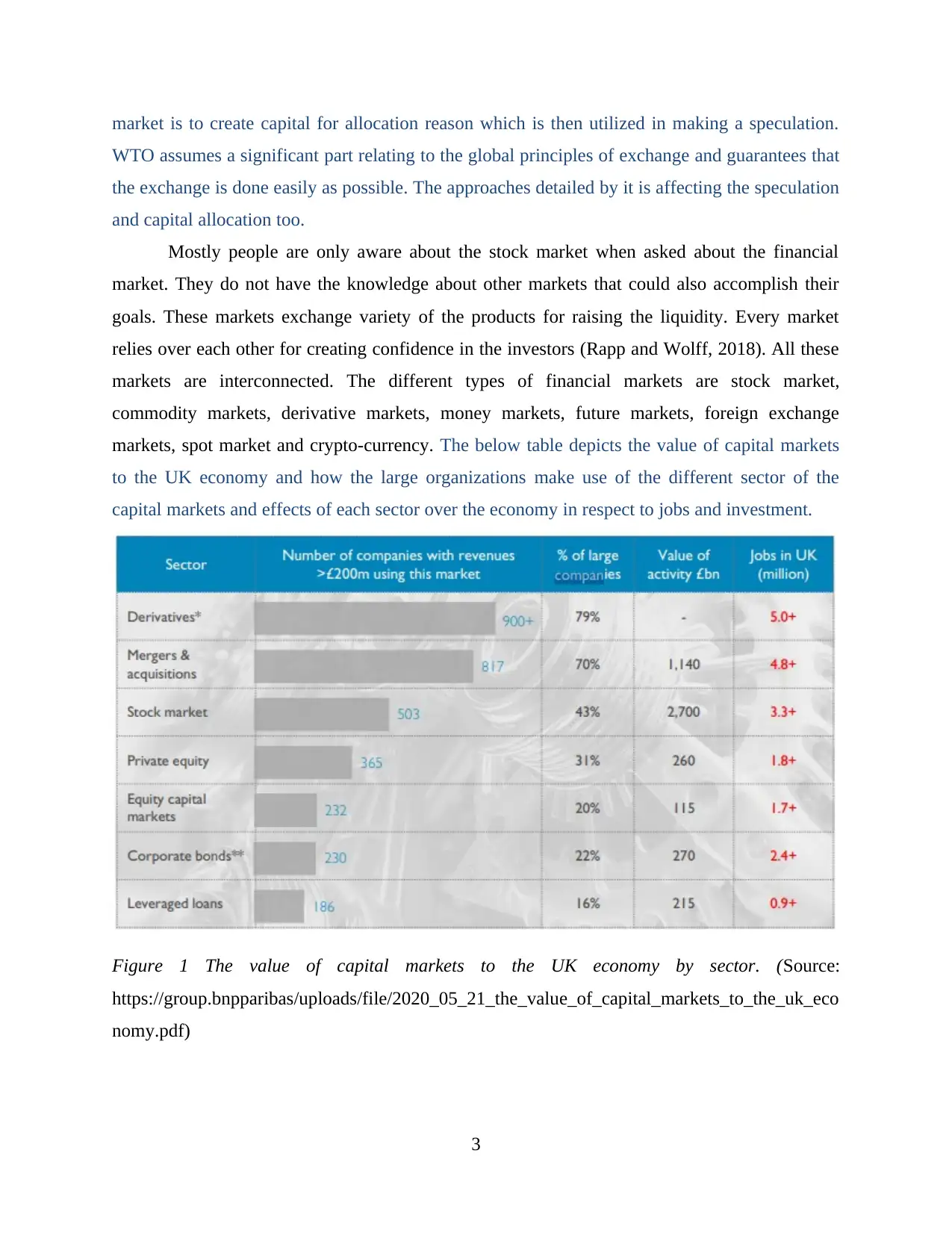
market is to create capital for allocation reason which is then utilized in making a speculation.
WTO assumes a significant part relating to the global principles of exchange and guarantees that
the exchange is done easily as possible. The approaches detailed by it is affecting the speculation
and capital allocation too.
Mostly people are only aware about the stock market when asked about the financial
market. They do not have the knowledge about other markets that could also accomplish their
goals. These markets exchange variety of the products for raising the liquidity. Every market
relies over each other for creating confidence in the investors (Rapp and Wolff, 2018). All these
markets are interconnected. The different types of financial markets are stock market,
commodity markets, derivative markets, money markets, future markets, foreign exchange
markets, spot market and crypto-currency. The below table depicts the value of capital markets
to the UK economy and how the large organizations make use of the different sector of the
capital markets and effects of each sector over the economy in respect to jobs and investment.
Figure 1 The value of capital markets to the UK economy by sector. (Source:
https://group.bnpparibas/uploads/file/2020_05_21_the_value_of_capital_markets_to_the_uk_eco
nomy.pdf)
3
WTO assumes a significant part relating to the global principles of exchange and guarantees that
the exchange is done easily as possible. The approaches detailed by it is affecting the speculation
and capital allocation too.
Mostly people are only aware about the stock market when asked about the financial
market. They do not have the knowledge about other markets that could also accomplish their
goals. These markets exchange variety of the products for raising the liquidity. Every market
relies over each other for creating confidence in the investors (Rapp and Wolff, 2018). All these
markets are interconnected. The different types of financial markets are stock market,
commodity markets, derivative markets, money markets, future markets, foreign exchange
markets, spot market and crypto-currency. The below table depicts the value of capital markets
to the UK economy and how the large organizations make use of the different sector of the
capital markets and effects of each sector over the economy in respect to jobs and investment.
Figure 1 The value of capital markets to the UK economy by sector. (Source:
https://group.bnpparibas/uploads/file/2020_05_21_the_value_of_capital_markets_to_the_uk_eco
nomy.pdf)
3
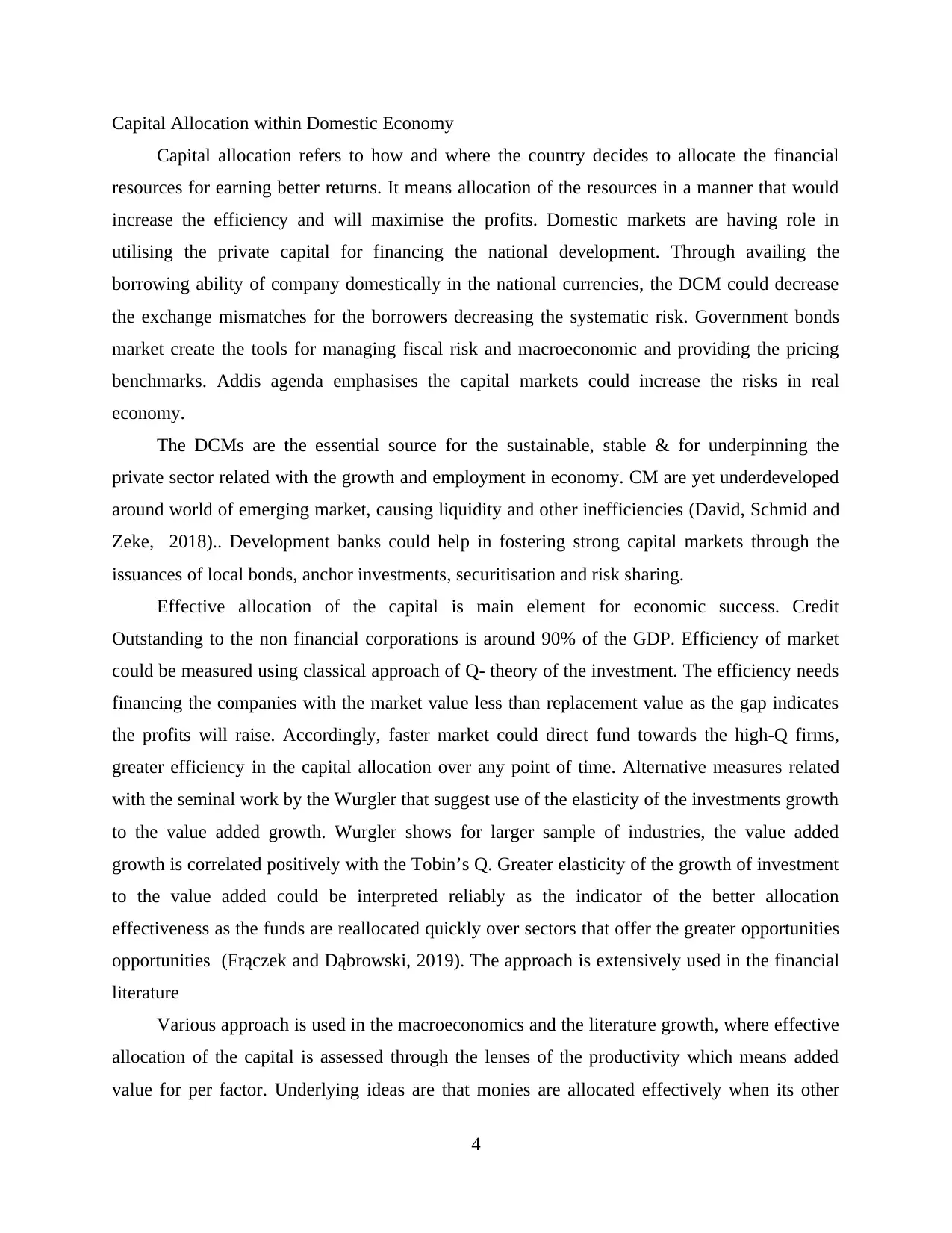
Capital Allocation within Domestic Economy
Capital allocation refers to how and where the country decides to allocate the financial
resources for earning better returns. It means allocation of the resources in a manner that would
increase the efficiency and will maximise the profits. Domestic markets are having role in
utilising the private capital for financing the national development. Through availing the
borrowing ability of company domestically in the national currencies, the DCM could decrease
the exchange mismatches for the borrowers decreasing the systematic risk. Government bonds
market create the tools for managing fiscal risk and macroeconomic and providing the pricing
benchmarks. Addis agenda emphasises the capital markets could increase the risks in real
economy.
The DCMs are the essential source for the sustainable, stable & for underpinning the
private sector related with the growth and employment in economy. CM are yet underdeveloped
around world of emerging market, causing liquidity and other inefficiencies (David, Schmid and
Zeke, 2018).. Development banks could help in fostering strong capital markets through the
issuances of local bonds, anchor investments, securitisation and risk sharing.
Effective allocation of the capital is main element for economic success. Credit
Outstanding to the non financial corporations is around 90% of the GDP. Efficiency of market
could be measured using classical approach of Q- theory of the investment. The efficiency needs
financing the companies with the market value less than replacement value as the gap indicates
the profits will raise. Accordingly, faster market could direct fund towards the high-Q firms,
greater efficiency in the capital allocation over any point of time. Alternative measures related
with the seminal work by the Wurgler that suggest use of the elasticity of the investments growth
to the value added growth. Wurgler shows for larger sample of industries, the value added
growth is correlated positively with the Tobin’s Q. Greater elasticity of the growth of investment
to the value added could be interpreted reliably as the indicator of the better allocation
effectiveness as the funds are reallocated quickly over sectors that offer the greater opportunities
opportunities (Frączek and Dąbrowski, 2019). The approach is extensively used in the financial
literature
Various approach is used in the macroeconomics and the literature growth, where effective
allocation of the capital is assessed through the lenses of the productivity which means added
value for per factor. Underlying ideas are that monies are allocated effectively when its other
4
Capital allocation refers to how and where the country decides to allocate the financial
resources for earning better returns. It means allocation of the resources in a manner that would
increase the efficiency and will maximise the profits. Domestic markets are having role in
utilising the private capital for financing the national development. Through availing the
borrowing ability of company domestically in the national currencies, the DCM could decrease
the exchange mismatches for the borrowers decreasing the systematic risk. Government bonds
market create the tools for managing fiscal risk and macroeconomic and providing the pricing
benchmarks. Addis agenda emphasises the capital markets could increase the risks in real
economy.
The DCMs are the essential source for the sustainable, stable & for underpinning the
private sector related with the growth and employment in economy. CM are yet underdeveloped
around world of emerging market, causing liquidity and other inefficiencies (David, Schmid and
Zeke, 2018).. Development banks could help in fostering strong capital markets through the
issuances of local bonds, anchor investments, securitisation and risk sharing.
Effective allocation of the capital is main element for economic success. Credit
Outstanding to the non financial corporations is around 90% of the GDP. Efficiency of market
could be measured using classical approach of Q- theory of the investment. The efficiency needs
financing the companies with the market value less than replacement value as the gap indicates
the profits will raise. Accordingly, faster market could direct fund towards the high-Q firms,
greater efficiency in the capital allocation over any point of time. Alternative measures related
with the seminal work by the Wurgler that suggest use of the elasticity of the investments growth
to the value added growth. Wurgler shows for larger sample of industries, the value added
growth is correlated positively with the Tobin’s Q. Greater elasticity of the growth of investment
to the value added could be interpreted reliably as the indicator of the better allocation
effectiveness as the funds are reallocated quickly over sectors that offer the greater opportunities
opportunities (Frączek and Dąbrowski, 2019). The approach is extensively used in the financial
literature
Various approach is used in the macroeconomics and the literature growth, where effective
allocation of the capital is assessed through the lenses of the productivity which means added
value for per factor. Underlying ideas are that monies are allocated effectively when its other
4
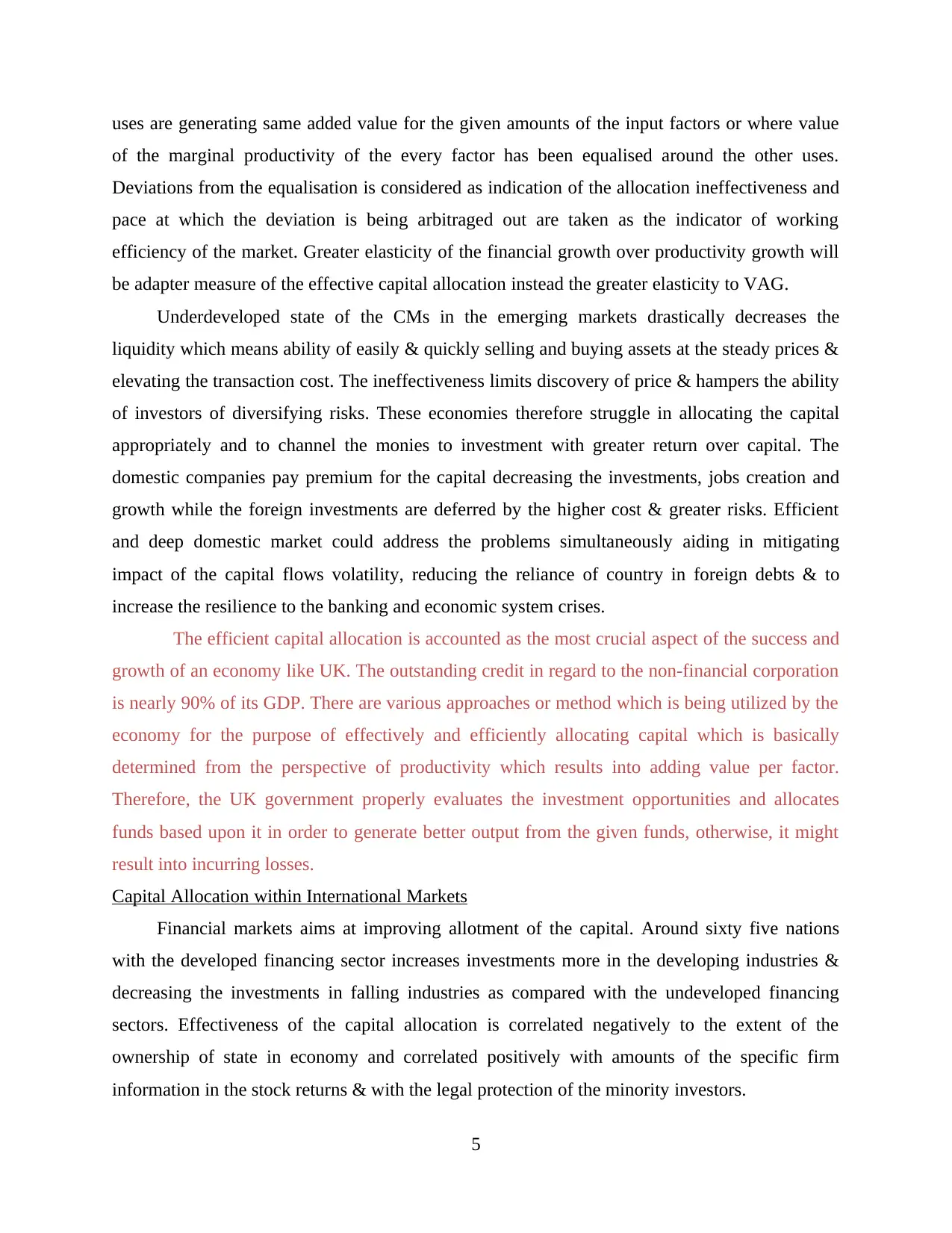
uses are generating same added value for the given amounts of the input factors or where value
of the marginal productivity of the every factor has been equalised around the other uses.
Deviations from the equalisation is considered as indication of the allocation ineffectiveness and
pace at which the deviation is being arbitraged out are taken as the indicator of working
efficiency of the market. Greater elasticity of the financial growth over productivity growth will
be adapter measure of the effective capital allocation instead the greater elasticity to VAG.
Underdeveloped state of the CMs in the emerging markets drastically decreases the
liquidity which means ability of easily & quickly selling and buying assets at the steady prices &
elevating the transaction cost. The ineffectiveness limits discovery of price & hampers the ability
of investors of diversifying risks. These economies therefore struggle in allocating the capital
appropriately and to channel the monies to investment with greater return over capital. The
domestic companies pay premium for the capital decreasing the investments, jobs creation and
growth while the foreign investments are deferred by the higher cost & greater risks. Efficient
and deep domestic market could address the problems simultaneously aiding in mitigating
impact of the capital flows volatility, reducing the reliance of country in foreign debts & to
increase the resilience to the banking and economic system crises.
The efficient capital allocation is accounted as the most crucial aspect of the success and
growth of an economy like UK. The outstanding credit in regard to the non-financial corporation
is nearly 90% of its GDP. There are various approaches or method which is being utilized by the
economy for the purpose of effectively and efficiently allocating capital which is basically
determined from the perspective of productivity which results into adding value per factor.
Therefore, the UK government properly evaluates the investment opportunities and allocates
funds based upon it in order to generate better output from the given funds, otherwise, it might
result into incurring losses.
Capital Allocation within International Markets
Financial markets aims at improving allotment of the capital. Around sixty five nations
with the developed financing sector increases investments more in the developing industries &
decreasing the investments in falling industries as compared with the undeveloped financing
sectors. Effectiveness of the capital allocation is correlated negatively to the extent of the
ownership of state in economy and correlated positively with amounts of the specific firm
information in the stock returns & with the legal protection of the minority investors.
5
of the marginal productivity of the every factor has been equalised around the other uses.
Deviations from the equalisation is considered as indication of the allocation ineffectiveness and
pace at which the deviation is being arbitraged out are taken as the indicator of working
efficiency of the market. Greater elasticity of the financial growth over productivity growth will
be adapter measure of the effective capital allocation instead the greater elasticity to VAG.
Underdeveloped state of the CMs in the emerging markets drastically decreases the
liquidity which means ability of easily & quickly selling and buying assets at the steady prices &
elevating the transaction cost. The ineffectiveness limits discovery of price & hampers the ability
of investors of diversifying risks. These economies therefore struggle in allocating the capital
appropriately and to channel the monies to investment with greater return over capital. The
domestic companies pay premium for the capital decreasing the investments, jobs creation and
growth while the foreign investments are deferred by the higher cost & greater risks. Efficient
and deep domestic market could address the problems simultaneously aiding in mitigating
impact of the capital flows volatility, reducing the reliance of country in foreign debts & to
increase the resilience to the banking and economic system crises.
The efficient capital allocation is accounted as the most crucial aspect of the success and
growth of an economy like UK. The outstanding credit in regard to the non-financial corporation
is nearly 90% of its GDP. There are various approaches or method which is being utilized by the
economy for the purpose of effectively and efficiently allocating capital which is basically
determined from the perspective of productivity which results into adding value per factor.
Therefore, the UK government properly evaluates the investment opportunities and allocates
funds based upon it in order to generate better output from the given funds, otherwise, it might
result into incurring losses.
Capital Allocation within International Markets
Financial markets aims at improving allotment of the capital. Around sixty five nations
with the developed financing sector increases investments more in the developing industries &
decreasing the investments in falling industries as compared with the undeveloped financing
sectors. Effectiveness of the capital allocation is correlated negatively to the extent of the
ownership of state in economy and correlated positively with amounts of the specific firm
information in the stock returns & with the legal protection of the minority investors.
5
Paraphrase This Document
Need a fresh take? Get an instant paraphrase of this document with our AI Paraphraser
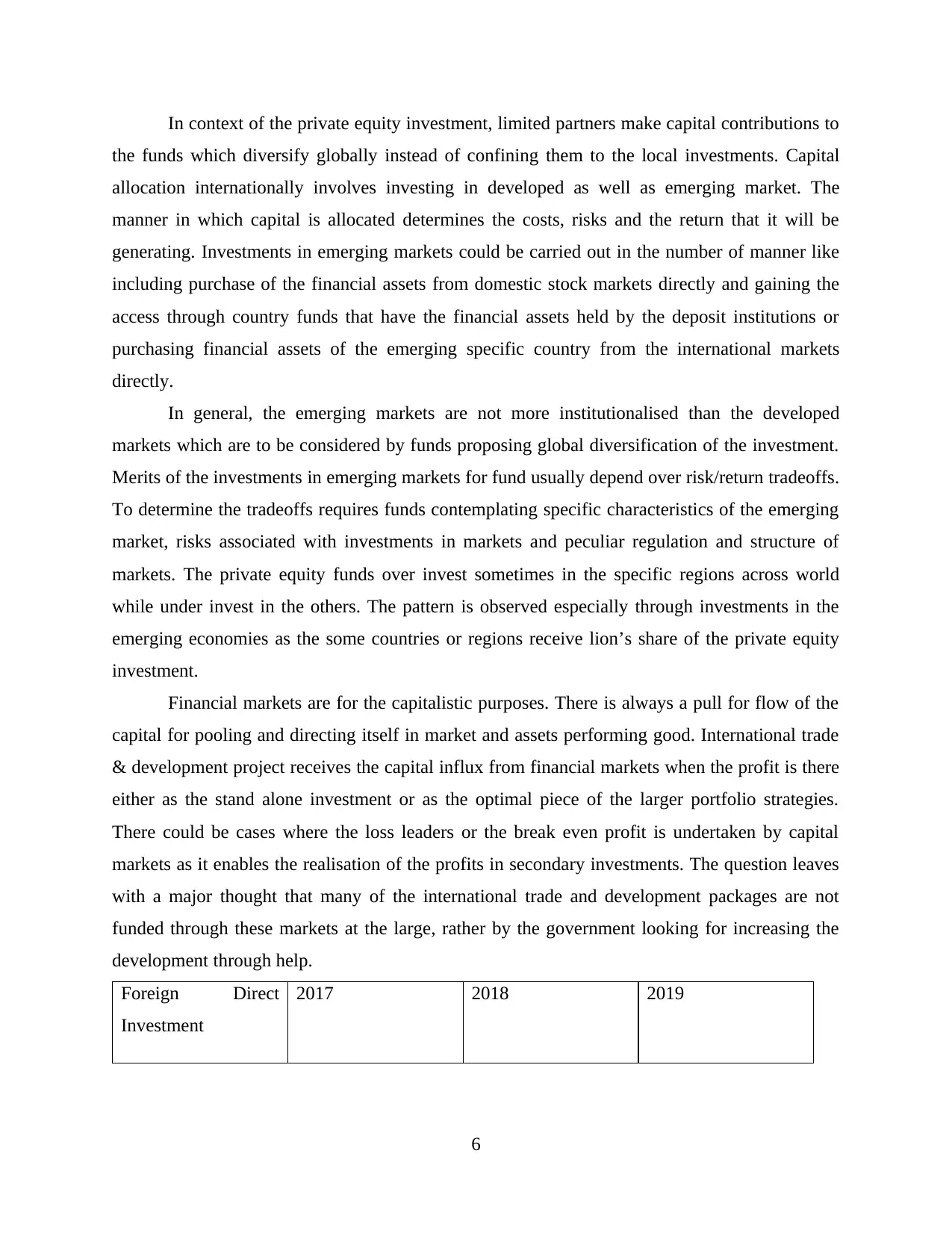
In context of the private equity investment, limited partners make capital contributions to
the funds which diversify globally instead of confining them to the local investments. Capital
allocation internationally involves investing in developed as well as emerging market. The
manner in which capital is allocated determines the costs, risks and the return that it will be
generating. Investments in emerging markets could be carried out in the number of manner like
including purchase of the financial assets from domestic stock markets directly and gaining the
access through country funds that have the financial assets held by the deposit institutions or
purchasing financial assets of the emerging specific country from the international markets
directly.
In general, the emerging markets are not more institutionalised than the developed
markets which are to be considered by funds proposing global diversification of the investment.
Merits of the investments in emerging markets for fund usually depend over risk/return tradeoffs.
To determine the tradeoffs requires funds contemplating specific characteristics of the emerging
market, risks associated with investments in markets and peculiar regulation and structure of
markets. The private equity funds over invest sometimes in the specific regions across world
while under invest in the others. The pattern is observed especially through investments in the
emerging economies as the some countries or regions receive lion’s share of the private equity
investment.
Financial markets are for the capitalistic purposes. There is always a pull for flow of the
capital for pooling and directing itself in market and assets performing good. International trade
& development project receives the capital influx from financial markets when the profit is there
either as the stand alone investment or as the optimal piece of the larger portfolio strategies.
There could be cases where the loss leaders or the break even profit is undertaken by capital
markets as it enables the realisation of the profits in secondary investments. The question leaves
with a major thought that many of the international trade and development packages are not
funded through these markets at the large, rather by the government looking for increasing the
development through help.
Foreign Direct
Investment
2017 2018 2019
6
the funds which diversify globally instead of confining them to the local investments. Capital
allocation internationally involves investing in developed as well as emerging market. The
manner in which capital is allocated determines the costs, risks and the return that it will be
generating. Investments in emerging markets could be carried out in the number of manner like
including purchase of the financial assets from domestic stock markets directly and gaining the
access through country funds that have the financial assets held by the deposit institutions or
purchasing financial assets of the emerging specific country from the international markets
directly.
In general, the emerging markets are not more institutionalised than the developed
markets which are to be considered by funds proposing global diversification of the investment.
Merits of the investments in emerging markets for fund usually depend over risk/return tradeoffs.
To determine the tradeoffs requires funds contemplating specific characteristics of the emerging
market, risks associated with investments in markets and peculiar regulation and structure of
markets. The private equity funds over invest sometimes in the specific regions across world
while under invest in the others. The pattern is observed especially through investments in the
emerging economies as the some countries or regions receive lion’s share of the private equity
investment.
Financial markets are for the capitalistic purposes. There is always a pull for flow of the
capital for pooling and directing itself in market and assets performing good. International trade
& development project receives the capital influx from financial markets when the profit is there
either as the stand alone investment or as the optimal piece of the larger portfolio strategies.
There could be cases where the loss leaders or the break even profit is undertaken by capital
markets as it enables the realisation of the profits in secondary investments. The question leaves
with a major thought that many of the international trade and development packages are not
funded through these markets at the large, rather by the government looking for increasing the
development through help.
Foreign Direct
Investment
2017 2018 2019
6
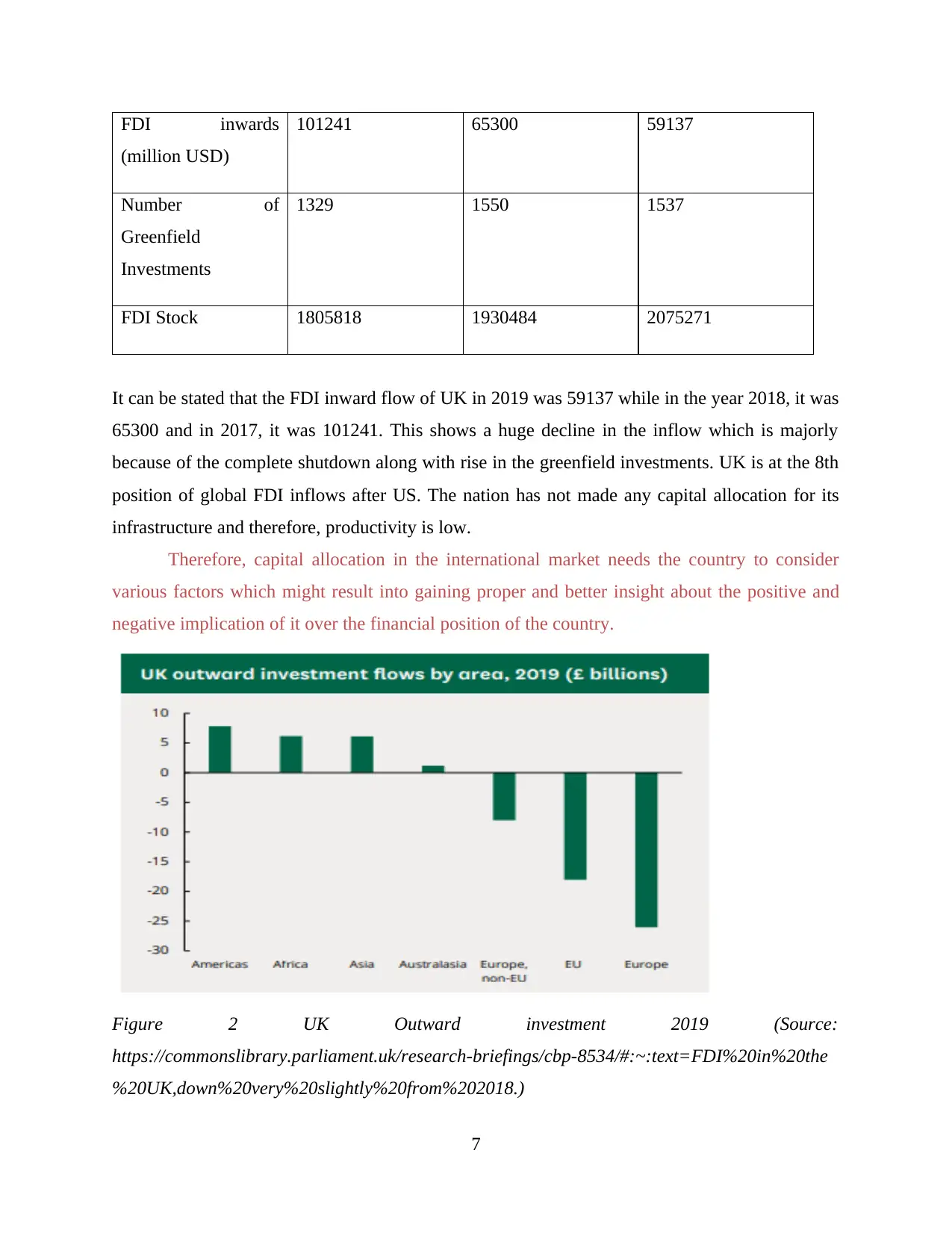
FDI inwards
(million USD)
101241 65300 59137
Number of
Greenfield
Investments
1329 1550 1537
FDI Stock 1805818 1930484 2075271
It can be stated that the FDI inward flow of UK in 2019 was 59137 while in the year 2018, it was
65300 and in 2017, it was 101241. This shows a huge decline in the inflow which is majorly
because of the complete shutdown along with rise in the greenfield investments. UK is at the 8th
position of global FDI inflows after US. The nation has not made any capital allocation for its
infrastructure and therefore, productivity is low.
Therefore, capital allocation in the international market needs the country to consider
various factors which might result into gaining proper and better insight about the positive and
negative implication of it over the financial position of the country.
Figure 2 UK Outward investment 2019 (Source:
https://commonslibrary.parliament.uk/research-briefings/cbp-8534/#:~:text=FDI%20in%20the
%20UK,down%20very%20slightly%20from%202018.)
7
(million USD)
101241 65300 59137
Number of
Greenfield
Investments
1329 1550 1537
FDI Stock 1805818 1930484 2075271
It can be stated that the FDI inward flow of UK in 2019 was 59137 while in the year 2018, it was
65300 and in 2017, it was 101241. This shows a huge decline in the inflow which is majorly
because of the complete shutdown along with rise in the greenfield investments. UK is at the 8th
position of global FDI inflows after US. The nation has not made any capital allocation for its
infrastructure and therefore, productivity is low.
Therefore, capital allocation in the international market needs the country to consider
various factors which might result into gaining proper and better insight about the positive and
negative implication of it over the financial position of the country.
Figure 2 UK Outward investment 2019 (Source:
https://commonslibrary.parliament.uk/research-briefings/cbp-8534/#:~:text=FDI%20in%20the
%20UK,down%20very%20slightly%20from%202018.)
7
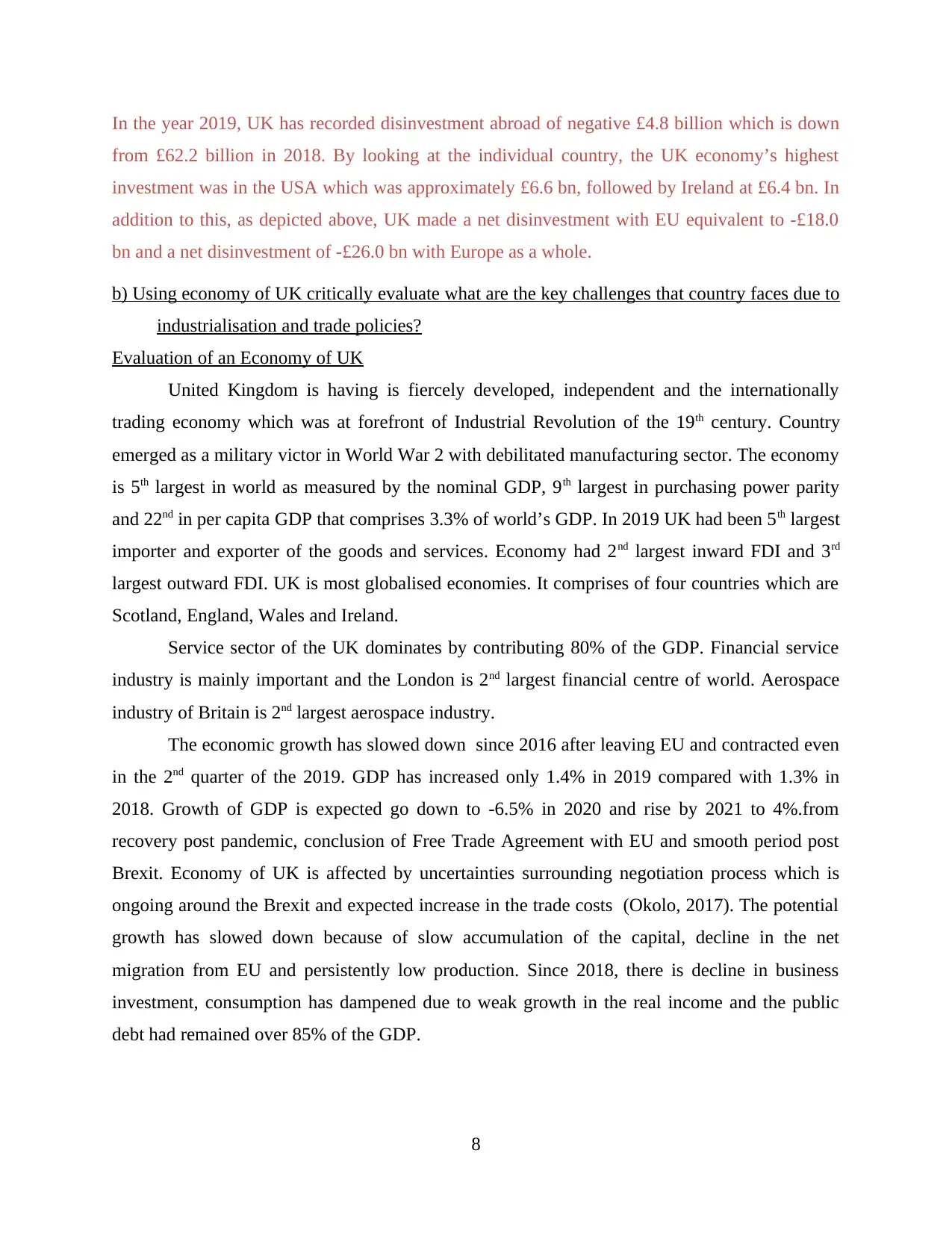
In the year 2019, UK has recorded disinvestment abroad of negative £4.8 billion which is down
from £62.2 billion in 2018. By looking at the individual country, the UK economy’s highest
investment was in the USA which was approximately £6.6 bn, followed by Ireland at £6.4 bn. In
addition to this, as depicted above, UK made a net disinvestment with EU equivalent to -£18.0
bn and a net disinvestment of -£26.0 bn with Europe as a whole.
b) Using economy of UK critically evaluate what are the key challenges that country faces due to
industrialisation and trade policies?
Evaluation of an Economy of UK
United Kingdom is having is fiercely developed, independent and the internationally
trading economy which was at forefront of Industrial Revolution of the 19th century. Country
emerged as a military victor in World War 2 with debilitated manufacturing sector. The economy
is 5th largest in world as measured by the nominal GDP, 9th largest in purchasing power parity
and 22nd in per capita GDP that comprises 3.3% of world’s GDP. In 2019 UK had been 5th largest
importer and exporter of the goods and services. Economy had 2nd largest inward FDI and 3rd
largest outward FDI. UK is most globalised economies. It comprises of four countries which are
Scotland, England, Wales and Ireland.
Service sector of the UK dominates by contributing 80% of the GDP. Financial service
industry is mainly important and the London is 2nd largest financial centre of world. Aerospace
industry of Britain is 2nd largest aerospace industry.
The economic growth has slowed down since 2016 after leaving EU and contracted even
in the 2nd quarter of the 2019. GDP has increased only 1.4% in 2019 compared with 1.3% in
2018. Growth of GDP is expected go down to -6.5% in 2020 and rise by 2021 to 4%.from
recovery post pandemic, conclusion of Free Trade Agreement with EU and smooth period post
Brexit. Economy of UK is affected by uncertainties surrounding negotiation process which is
ongoing around the Brexit and expected increase in the trade costs (Okolo, 2017). The potential
growth has slowed down because of slow accumulation of the capital, decline in the net
migration from EU and persistently low production. Since 2018, there is decline in business
investment, consumption has dampened due to weak growth in the real income and the public
debt had remained over 85% of the GDP.
8
from £62.2 billion in 2018. By looking at the individual country, the UK economy’s highest
investment was in the USA which was approximately £6.6 bn, followed by Ireland at £6.4 bn. In
addition to this, as depicted above, UK made a net disinvestment with EU equivalent to -£18.0
bn and a net disinvestment of -£26.0 bn with Europe as a whole.
b) Using economy of UK critically evaluate what are the key challenges that country faces due to
industrialisation and trade policies?
Evaluation of an Economy of UK
United Kingdom is having is fiercely developed, independent and the internationally
trading economy which was at forefront of Industrial Revolution of the 19th century. Country
emerged as a military victor in World War 2 with debilitated manufacturing sector. The economy
is 5th largest in world as measured by the nominal GDP, 9th largest in purchasing power parity
and 22nd in per capita GDP that comprises 3.3% of world’s GDP. In 2019 UK had been 5th largest
importer and exporter of the goods and services. Economy had 2nd largest inward FDI and 3rd
largest outward FDI. UK is most globalised economies. It comprises of four countries which are
Scotland, England, Wales and Ireland.
Service sector of the UK dominates by contributing 80% of the GDP. Financial service
industry is mainly important and the London is 2nd largest financial centre of world. Aerospace
industry of Britain is 2nd largest aerospace industry.
The economic growth has slowed down since 2016 after leaving EU and contracted even
in the 2nd quarter of the 2019. GDP has increased only 1.4% in 2019 compared with 1.3% in
2018. Growth of GDP is expected go down to -6.5% in 2020 and rise by 2021 to 4%.from
recovery post pandemic, conclusion of Free Trade Agreement with EU and smooth period post
Brexit. Economy of UK is affected by uncertainties surrounding negotiation process which is
ongoing around the Brexit and expected increase in the trade costs (Okolo, 2017). The potential
growth has slowed down because of slow accumulation of the capital, decline in the net
migration from EU and persistently low production. Since 2018, there is decline in business
investment, consumption has dampened due to weak growth in the real income and the public
debt had remained over 85% of the GDP.
8
Secure Best Marks with AI Grader
Need help grading? Try our AI Grader for instant feedback on your assignments.
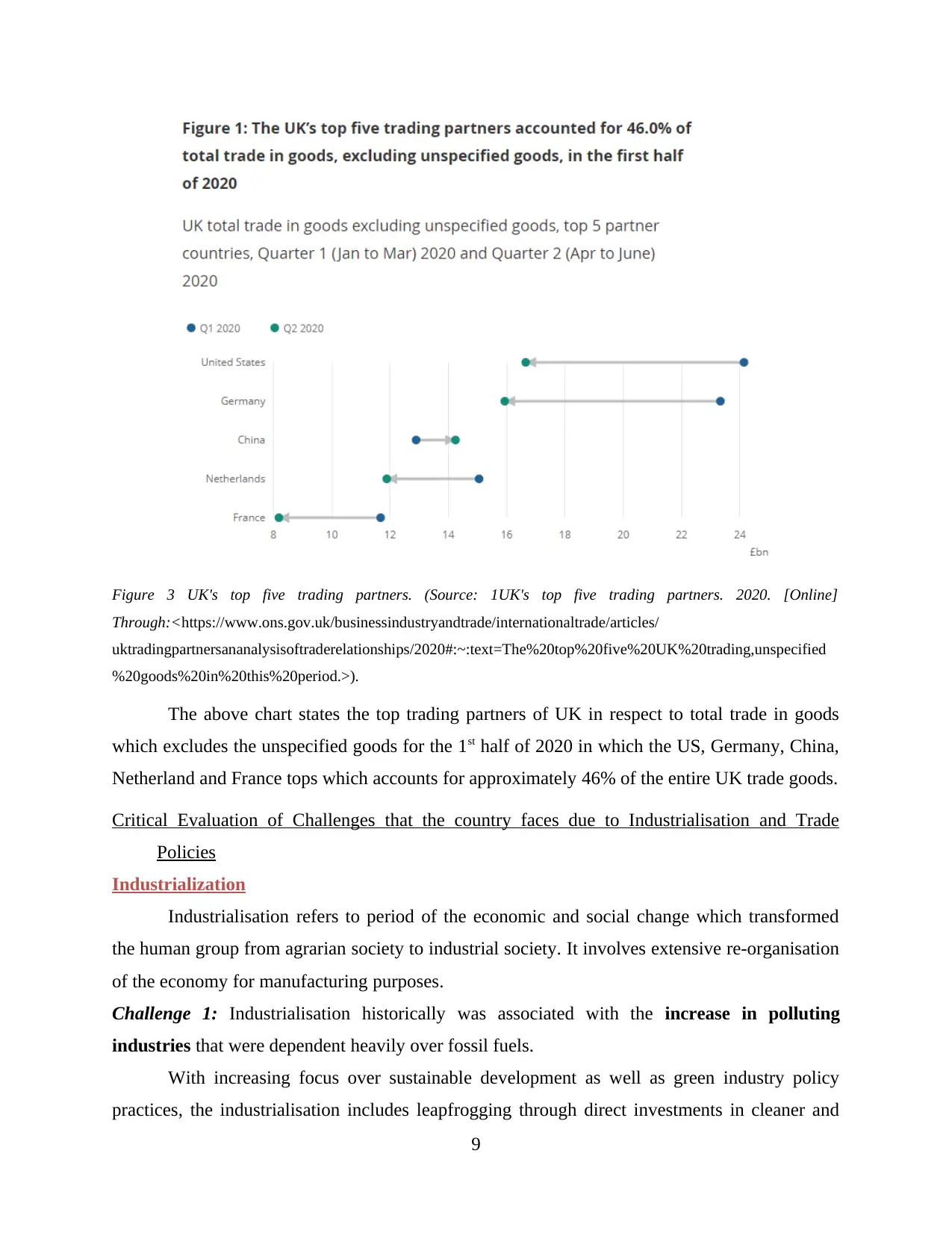
Figure 3 UK's top five trading partners. (Source: 1UK's top five trading partners. 2020. [Online]
Through:<https://www.ons.gov.uk/businessindustryandtrade/internationaltrade/articles/
uktradingpartnersananalysisoftraderelationships/2020#:~:text=The%20top%20five%20UK%20trading,unspecified
%20goods%20in%20this%20period.>).
The above chart states the top trading partners of UK in respect to total trade in goods
which excludes the unspecified goods for the 1st half of 2020 in which the US, Germany, China,
Netherland and France tops which accounts for approximately 46% of the entire UK trade goods.
Critical Evaluation of Challenges that the country faces due to Industrialisation and Trade
Policies
Industrialization
Industrialisation refers to period of the economic and social change which transformed
the human group from agrarian society to industrial society. It involves extensive re-organisation
of the economy for manufacturing purposes.
Challenge 1: Industrialisation historically was associated with the increase in polluting
industries that were dependent heavily over fossil fuels.
With increasing focus over sustainable development as well as green industry policy
practices, the industrialisation includes leapfrogging through direct investments in cleaner and
9
Through:<https://www.ons.gov.uk/businessindustryandtrade/internationaltrade/articles/
uktradingpartnersananalysisoftraderelationships/2020#:~:text=The%20top%20five%20UK%20trading,unspecified
%20goods%20in%20this%20period.>).
The above chart states the top trading partners of UK in respect to total trade in goods
which excludes the unspecified goods for the 1st half of 2020 in which the US, Germany, China,
Netherland and France tops which accounts for approximately 46% of the entire UK trade goods.
Critical Evaluation of Challenges that the country faces due to Industrialisation and Trade
Policies
Industrialization
Industrialisation refers to period of the economic and social change which transformed
the human group from agrarian society to industrial society. It involves extensive re-organisation
of the economy for manufacturing purposes.
Challenge 1: Industrialisation historically was associated with the increase in polluting
industries that were dependent heavily over fossil fuels.
With increasing focus over sustainable development as well as green industry policy
practices, the industrialisation includes leapfrogging through direct investments in cleaner and
9
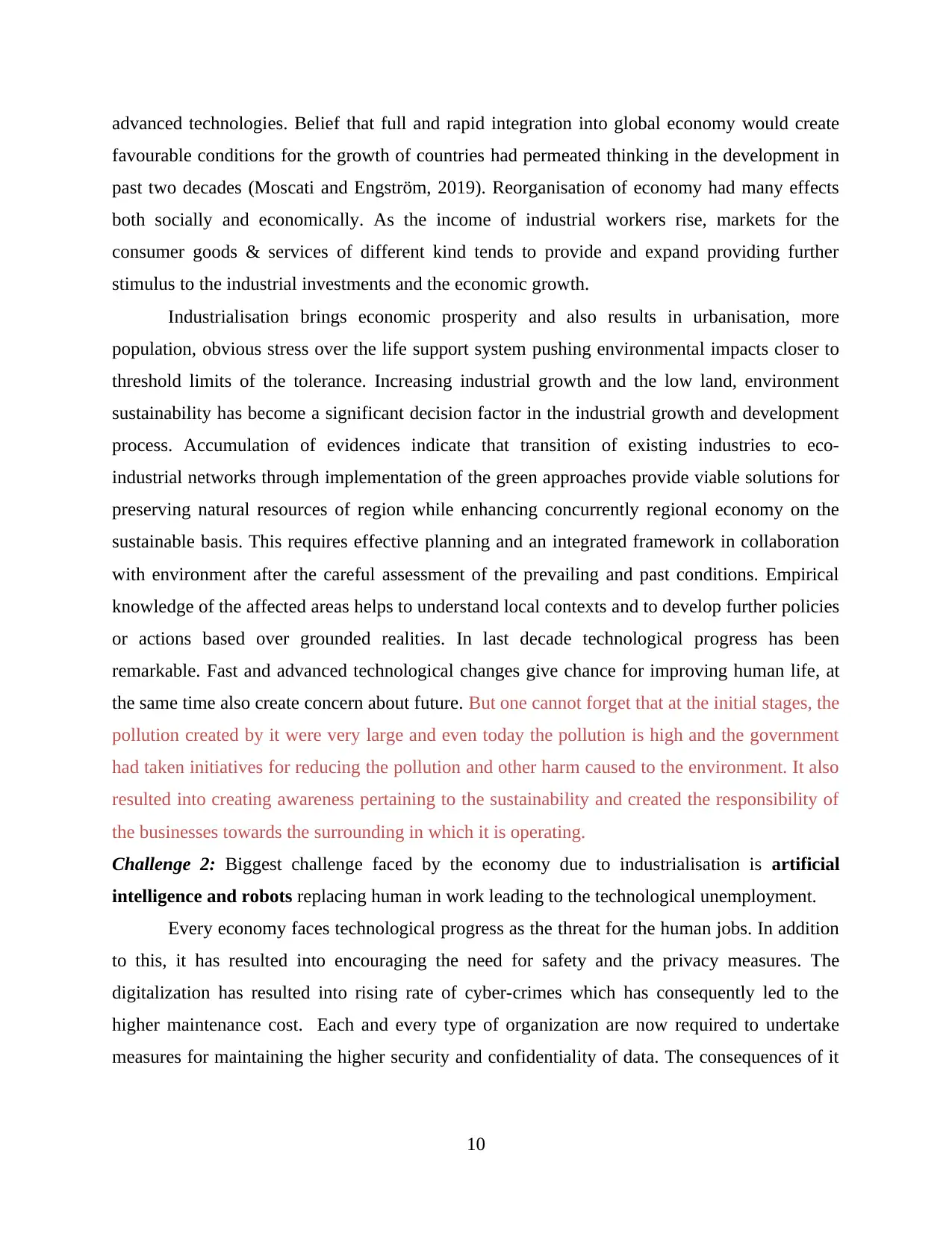
advanced technologies. Belief that full and rapid integration into global economy would create
favourable conditions for the growth of countries had permeated thinking in the development in
past two decades (Moscati and Engström, 2019). Reorganisation of economy had many effects
both socially and economically. As the income of industrial workers rise, markets for the
consumer goods & services of different kind tends to provide and expand providing further
stimulus to the industrial investments and the economic growth.
Industrialisation brings economic prosperity and also results in urbanisation, more
population, obvious stress over the life support system pushing environmental impacts closer to
threshold limits of the tolerance. Increasing industrial growth and the low land, environment
sustainability has become a significant decision factor in the industrial growth and development
process. Accumulation of evidences indicate that transition of existing industries to eco-
industrial networks through implementation of the green approaches provide viable solutions for
preserving natural resources of region while enhancing concurrently regional economy on the
sustainable basis. This requires effective planning and an integrated framework in collaboration
with environment after the careful assessment of the prevailing and past conditions. Empirical
knowledge of the affected areas helps to understand local contexts and to develop further policies
or actions based over grounded realities. In last decade technological progress has been
remarkable. Fast and advanced technological changes give chance for improving human life, at
the same time also create concern about future. But one cannot forget that at the initial stages, the
pollution created by it were very large and even today the pollution is high and the government
had taken initiatives for reducing the pollution and other harm caused to the environment. It also
resulted into creating awareness pertaining to the sustainability and created the responsibility of
the businesses towards the surrounding in which it is operating.
Challenge 2: Biggest challenge faced by the economy due to industrialisation is artificial
intelligence and robots replacing human in work leading to the technological unemployment.
Every economy faces technological progress as the threat for the human jobs. In addition
to this, it has resulted into encouraging the need for safety and the privacy measures. The
digitalization has resulted into rising rate of cyber-crimes which has consequently led to the
higher maintenance cost. Each and every type of organization are now required to undertake
measures for maintaining the higher security and confidentiality of data. The consequences of it
10
favourable conditions for the growth of countries had permeated thinking in the development in
past two decades (Moscati and Engström, 2019). Reorganisation of economy had many effects
both socially and economically. As the income of industrial workers rise, markets for the
consumer goods & services of different kind tends to provide and expand providing further
stimulus to the industrial investments and the economic growth.
Industrialisation brings economic prosperity and also results in urbanisation, more
population, obvious stress over the life support system pushing environmental impacts closer to
threshold limits of the tolerance. Increasing industrial growth and the low land, environment
sustainability has become a significant decision factor in the industrial growth and development
process. Accumulation of evidences indicate that transition of existing industries to eco-
industrial networks through implementation of the green approaches provide viable solutions for
preserving natural resources of region while enhancing concurrently regional economy on the
sustainable basis. This requires effective planning and an integrated framework in collaboration
with environment after the careful assessment of the prevailing and past conditions. Empirical
knowledge of the affected areas helps to understand local contexts and to develop further policies
or actions based over grounded realities. In last decade technological progress has been
remarkable. Fast and advanced technological changes give chance for improving human life, at
the same time also create concern about future. But one cannot forget that at the initial stages, the
pollution created by it were very large and even today the pollution is high and the government
had taken initiatives for reducing the pollution and other harm caused to the environment. It also
resulted into creating awareness pertaining to the sustainability and created the responsibility of
the businesses towards the surrounding in which it is operating.
Challenge 2: Biggest challenge faced by the economy due to industrialisation is artificial
intelligence and robots replacing human in work leading to the technological unemployment.
Every economy faces technological progress as the threat for the human jobs. In addition
to this, it has resulted into encouraging the need for safety and the privacy measures. The
digitalization has resulted into rising rate of cyber-crimes which has consequently led to the
higher maintenance cost. Each and every type of organization are now required to undertake
measures for maintaining the higher security and confidentiality of data. The consequences of it
10
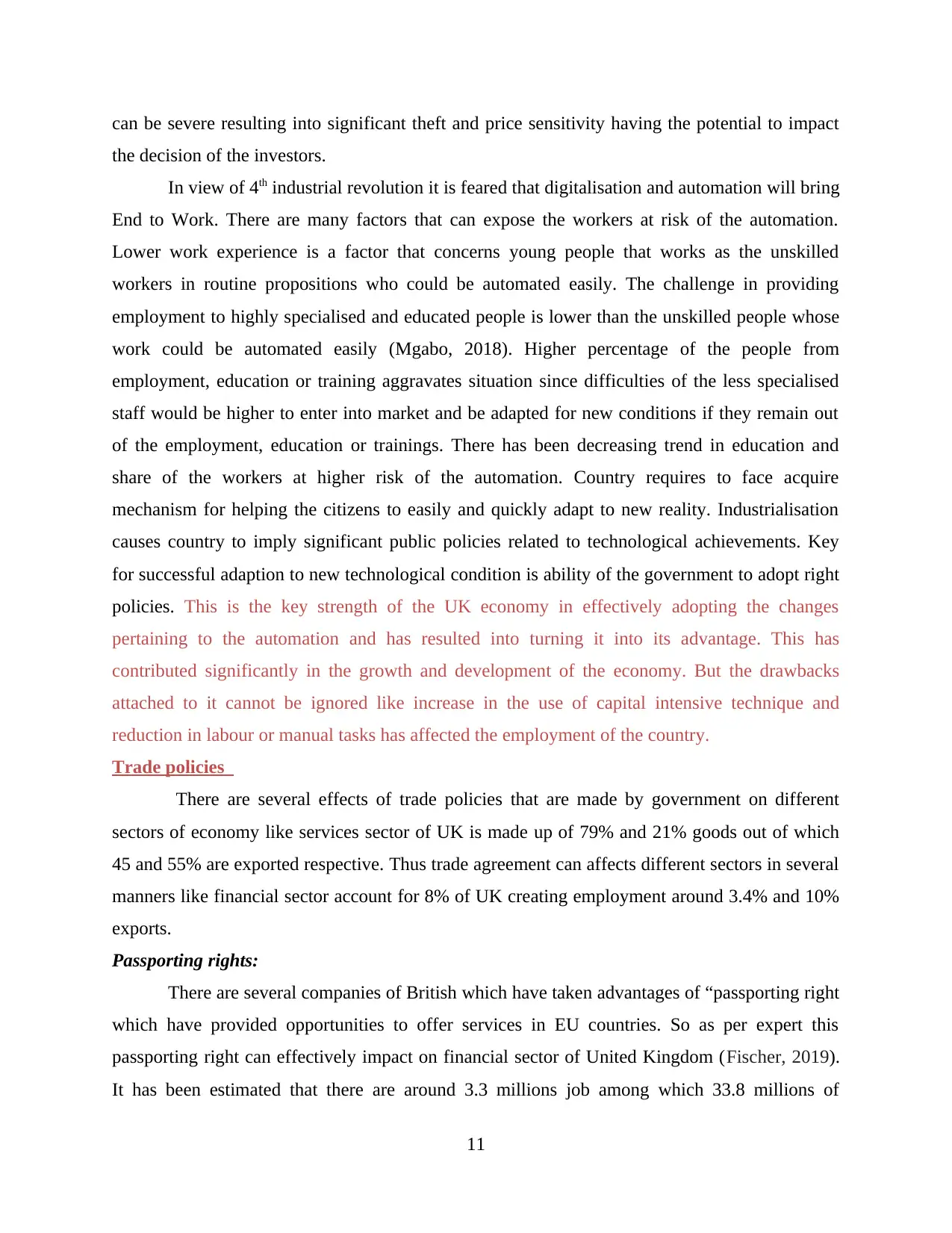
can be severe resulting into significant theft and price sensitivity having the potential to impact
the decision of the investors.
In view of 4th industrial revolution it is feared that digitalisation and automation will bring
End to Work. There are many factors that can expose the workers at risk of the automation.
Lower work experience is a factor that concerns young people that works as the unskilled
workers in routine propositions who could be automated easily. The challenge in providing
employment to highly specialised and educated people is lower than the unskilled people whose
work could be automated easily (Mgabo, 2018). Higher percentage of the people from
employment, education or training aggravates situation since difficulties of the less specialised
staff would be higher to enter into market and be adapted for new conditions if they remain out
of the employment, education or trainings. There has been decreasing trend in education and
share of the workers at higher risk of the automation. Country requires to face acquire
mechanism for helping the citizens to easily and quickly adapt to new reality. Industrialisation
causes country to imply significant public policies related to technological achievements. Key
for successful adaption to new technological condition is ability of the government to adopt right
policies. This is the key strength of the UK economy in effectively adopting the changes
pertaining to the automation and has resulted into turning it into its advantage. This has
contributed significantly in the growth and development of the economy. But the drawbacks
attached to it cannot be ignored like increase in the use of capital intensive technique and
reduction in labour or manual tasks has affected the employment of the country.
Trade policies
There are several effects of trade policies that are made by government on different
sectors of economy like services sector of UK is made up of 79% and 21% goods out of which
45 and 55% are exported respective. Thus trade agreement can affects different sectors in several
manners like financial sector account for 8% of UK creating employment around 3.4% and 10%
exports.
Passporting rights:
There are several companies of British which have taken advantages of “passporting right
which have provided opportunities to offer services in EU countries. So as per expert this
passporting right can effectively impact on financial sector of United Kingdom (Fischer, 2019).
It has been estimated that there are around 3.3 millions job among which 33.8 millions of
11
the decision of the investors.
In view of 4th industrial revolution it is feared that digitalisation and automation will bring
End to Work. There are many factors that can expose the workers at risk of the automation.
Lower work experience is a factor that concerns young people that works as the unskilled
workers in routine propositions who could be automated easily. The challenge in providing
employment to highly specialised and educated people is lower than the unskilled people whose
work could be automated easily (Mgabo, 2018). Higher percentage of the people from
employment, education or training aggravates situation since difficulties of the less specialised
staff would be higher to enter into market and be adapted for new conditions if they remain out
of the employment, education or trainings. There has been decreasing trend in education and
share of the workers at higher risk of the automation. Country requires to face acquire
mechanism for helping the citizens to easily and quickly adapt to new reality. Industrialisation
causes country to imply significant public policies related to technological achievements. Key
for successful adaption to new technological condition is ability of the government to adopt right
policies. This is the key strength of the UK economy in effectively adopting the changes
pertaining to the automation and has resulted into turning it into its advantage. This has
contributed significantly in the growth and development of the economy. But the drawbacks
attached to it cannot be ignored like increase in the use of capital intensive technique and
reduction in labour or manual tasks has affected the employment of the country.
Trade policies
There are several effects of trade policies that are made by government on different
sectors of economy like services sector of UK is made up of 79% and 21% goods out of which
45 and 55% are exported respective. Thus trade agreement can affects different sectors in several
manners like financial sector account for 8% of UK creating employment around 3.4% and 10%
exports.
Passporting rights:
There are several companies of British which have taken advantages of “passporting right
which have provided opportunities to offer services in EU countries. So as per expert this
passporting right can effectively impact on financial sector of United Kingdom (Fischer, 2019).
It has been estimated that there are around 3.3 millions job among which 33.8 millions of
11
Paraphrase This Document
Need a fresh take? Get an instant paraphrase of this document with our AI Paraphraser
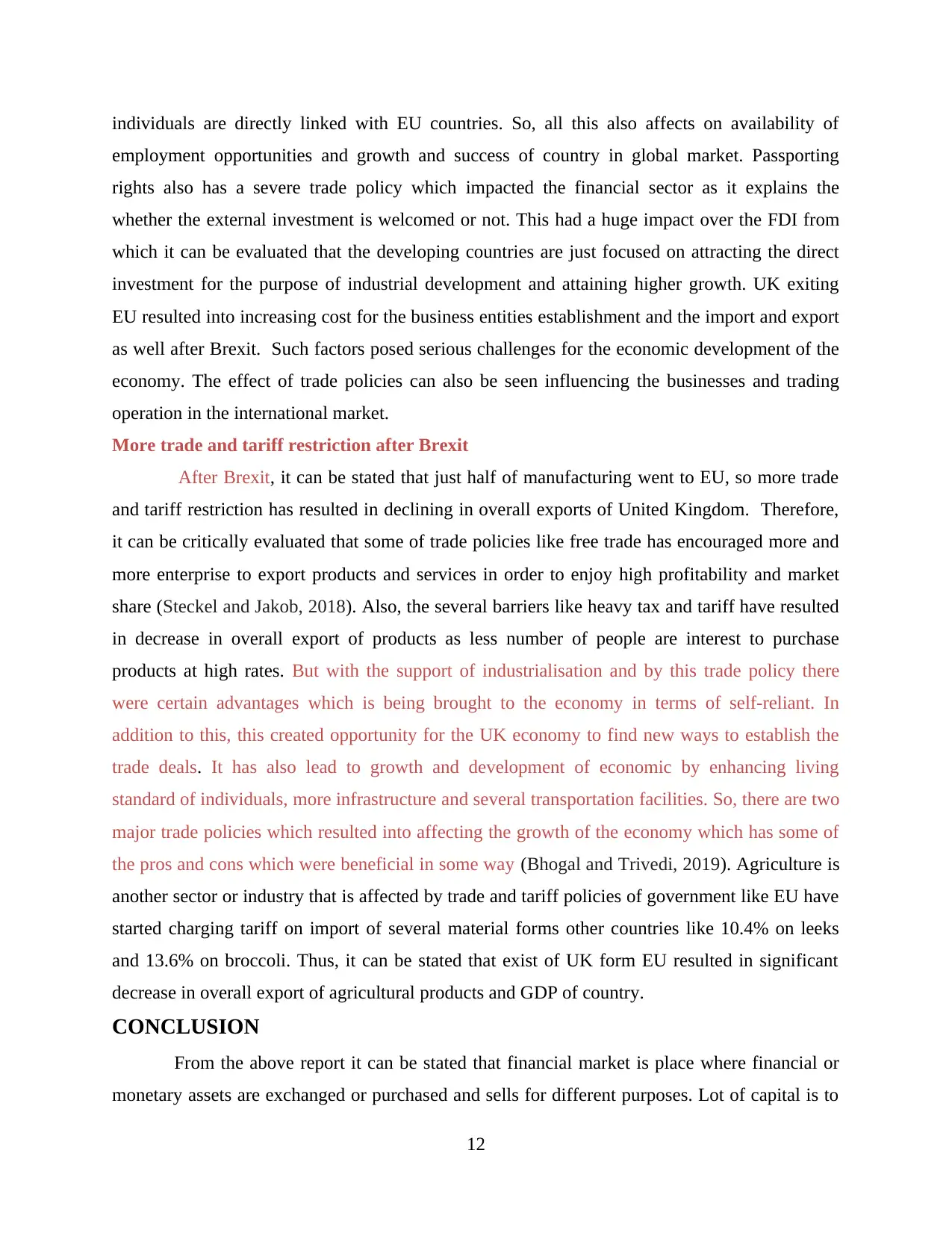
individuals are directly linked with EU countries. So, all this also affects on availability of
employment opportunities and growth and success of country in global market. Passporting
rights also has a severe trade policy which impacted the financial sector as it explains the
whether the external investment is welcomed or not. This had a huge impact over the FDI from
which it can be evaluated that the developing countries are just focused on attracting the direct
investment for the purpose of industrial development and attaining higher growth. UK exiting
EU resulted into increasing cost for the business entities establishment and the import and export
as well after Brexit. Such factors posed serious challenges for the economic development of the
economy. The effect of trade policies can also be seen influencing the businesses and trading
operation in the international market.
More trade and tariff restriction after Brexit
After Brexit, it can be stated that just half of manufacturing went to EU, so more trade
and tariff restriction has resulted in declining in overall exports of United Kingdom. Therefore,
it can be critically evaluated that some of trade policies like free trade has encouraged more and
more enterprise to export products and services in order to enjoy high profitability and market
share (Steckel and Jakob, 2018). Also, the several barriers like heavy tax and tariff have resulted
in decrease in overall export of products as less number of people are interest to purchase
products at high rates. But with the support of industrialisation and by this trade policy there
were certain advantages which is being brought to the economy in terms of self-reliant. In
addition to this, this created opportunity for the UK economy to find new ways to establish the
trade deals. It has also lead to growth and development of economic by enhancing living
standard of individuals, more infrastructure and several transportation facilities. So, there are two
major trade policies which resulted into affecting the growth of the economy which has some of
the pros and cons which were beneficial in some way (Bhogal and Trivedi, 2019). Agriculture is
another sector or industry that is affected by trade and tariff policies of government like EU have
started charging tariff on import of several material forms other countries like 10.4% on leeks
and 13.6% on broccoli. Thus, it can be stated that exist of UK form EU resulted in significant
decrease in overall export of agricultural products and GDP of country.
CONCLUSION
From the above report it can be stated that financial market is place where financial or
monetary assets are exchanged or purchased and sells for different purposes. Lot of capital is to
12
employment opportunities and growth and success of country in global market. Passporting
rights also has a severe trade policy which impacted the financial sector as it explains the
whether the external investment is welcomed or not. This had a huge impact over the FDI from
which it can be evaluated that the developing countries are just focused on attracting the direct
investment for the purpose of industrial development and attaining higher growth. UK exiting
EU resulted into increasing cost for the business entities establishment and the import and export
as well after Brexit. Such factors posed serious challenges for the economic development of the
economy. The effect of trade policies can also be seen influencing the businesses and trading
operation in the international market.
More trade and tariff restriction after Brexit
After Brexit, it can be stated that just half of manufacturing went to EU, so more trade
and tariff restriction has resulted in declining in overall exports of United Kingdom. Therefore,
it can be critically evaluated that some of trade policies like free trade has encouraged more and
more enterprise to export products and services in order to enjoy high profitability and market
share (Steckel and Jakob, 2018). Also, the several barriers like heavy tax and tariff have resulted
in decrease in overall export of products as less number of people are interest to purchase
products at high rates. But with the support of industrialisation and by this trade policy there
were certain advantages which is being brought to the economy in terms of self-reliant. In
addition to this, this created opportunity for the UK economy to find new ways to establish the
trade deals. It has also lead to growth and development of economic by enhancing living
standard of individuals, more infrastructure and several transportation facilities. So, there are two
major trade policies which resulted into affecting the growth of the economy which has some of
the pros and cons which were beneficial in some way (Bhogal and Trivedi, 2019). Agriculture is
another sector or industry that is affected by trade and tariff policies of government like EU have
started charging tariff on import of several material forms other countries like 10.4% on leeks
and 13.6% on broccoli. Thus, it can be stated that exist of UK form EU resulted in significant
decrease in overall export of agricultural products and GDP of country.
CONCLUSION
From the above report it can be stated that financial market is place where financial or
monetary assets are exchanged or purchased and sells for different purposes. Lot of capital is to
12
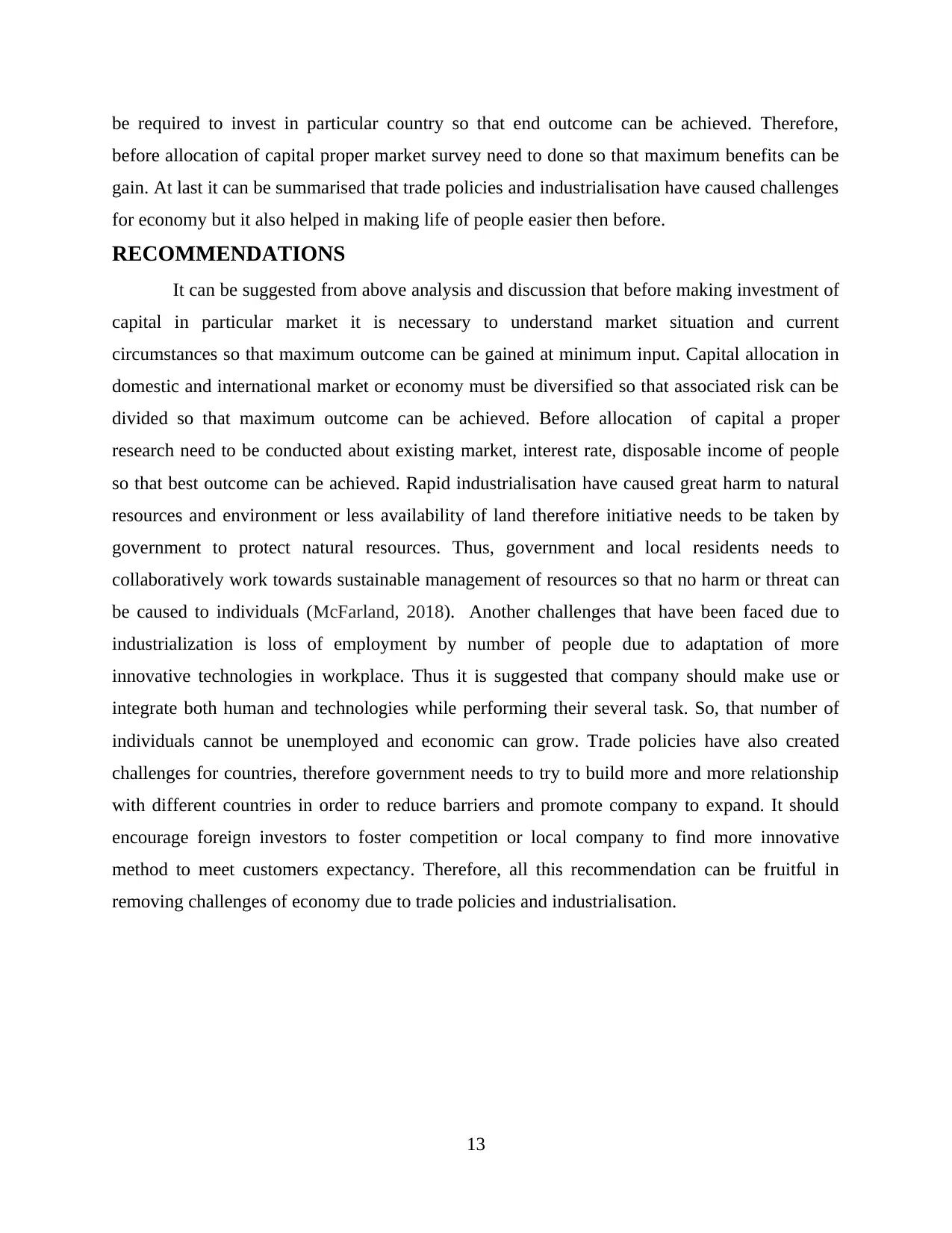
be required to invest in particular country so that end outcome can be achieved. Therefore,
before allocation of capital proper market survey need to done so that maximum benefits can be
gain. At last it can be summarised that trade policies and industrialisation have caused challenges
for economy but it also helped in making life of people easier then before.
RECOMMENDATIONS
It can be suggested from above analysis and discussion that before making investment of
capital in particular market it is necessary to understand market situation and current
circumstances so that maximum outcome can be gained at minimum input. Capital allocation in
domestic and international market or economy must be diversified so that associated risk can be
divided so that maximum outcome can be achieved. Before allocation of capital a proper
research need to be conducted about existing market, interest rate, disposable income of people
so that best outcome can be achieved. Rapid industrialisation have caused great harm to natural
resources and environment or less availability of land therefore initiative needs to be taken by
government to protect natural resources. Thus, government and local residents needs to
collaboratively work towards sustainable management of resources so that no harm or threat can
be caused to individuals (McFarland, 2018). Another challenges that have been faced due to
industrialization is loss of employment by number of people due to adaptation of more
innovative technologies in workplace. Thus it is suggested that company should make use or
integrate both human and technologies while performing their several task. So, that number of
individuals cannot be unemployed and economic can grow. Trade policies have also created
challenges for countries, therefore government needs to try to build more and more relationship
with different countries in order to reduce barriers and promote company to expand. It should
encourage foreign investors to foster competition or local company to find more innovative
method to meet customers expectancy. Therefore, all this recommendation can be fruitful in
removing challenges of economy due to trade policies and industrialisation.
13
before allocation of capital proper market survey need to done so that maximum benefits can be
gain. At last it can be summarised that trade policies and industrialisation have caused challenges
for economy but it also helped in making life of people easier then before.
RECOMMENDATIONS
It can be suggested from above analysis and discussion that before making investment of
capital in particular market it is necessary to understand market situation and current
circumstances so that maximum outcome can be gained at minimum input. Capital allocation in
domestic and international market or economy must be diversified so that associated risk can be
divided so that maximum outcome can be achieved. Before allocation of capital a proper
research need to be conducted about existing market, interest rate, disposable income of people
so that best outcome can be achieved. Rapid industrialisation have caused great harm to natural
resources and environment or less availability of land therefore initiative needs to be taken by
government to protect natural resources. Thus, government and local residents needs to
collaboratively work towards sustainable management of resources so that no harm or threat can
be caused to individuals (McFarland, 2018). Another challenges that have been faced due to
industrialization is loss of employment by number of people due to adaptation of more
innovative technologies in workplace. Thus it is suggested that company should make use or
integrate both human and technologies while performing their several task. So, that number of
individuals cannot be unemployed and economic can grow. Trade policies have also created
challenges for countries, therefore government needs to try to build more and more relationship
with different countries in order to reduce barriers and promote company to expand. It should
encourage foreign investors to foster competition or local company to find more innovative
method to meet customers expectancy. Therefore, all this recommendation can be fruitful in
removing challenges of economy due to trade policies and industrialisation.
13

14
Secure Best Marks with AI Grader
Need help grading? Try our AI Grader for instant feedback on your assignments.
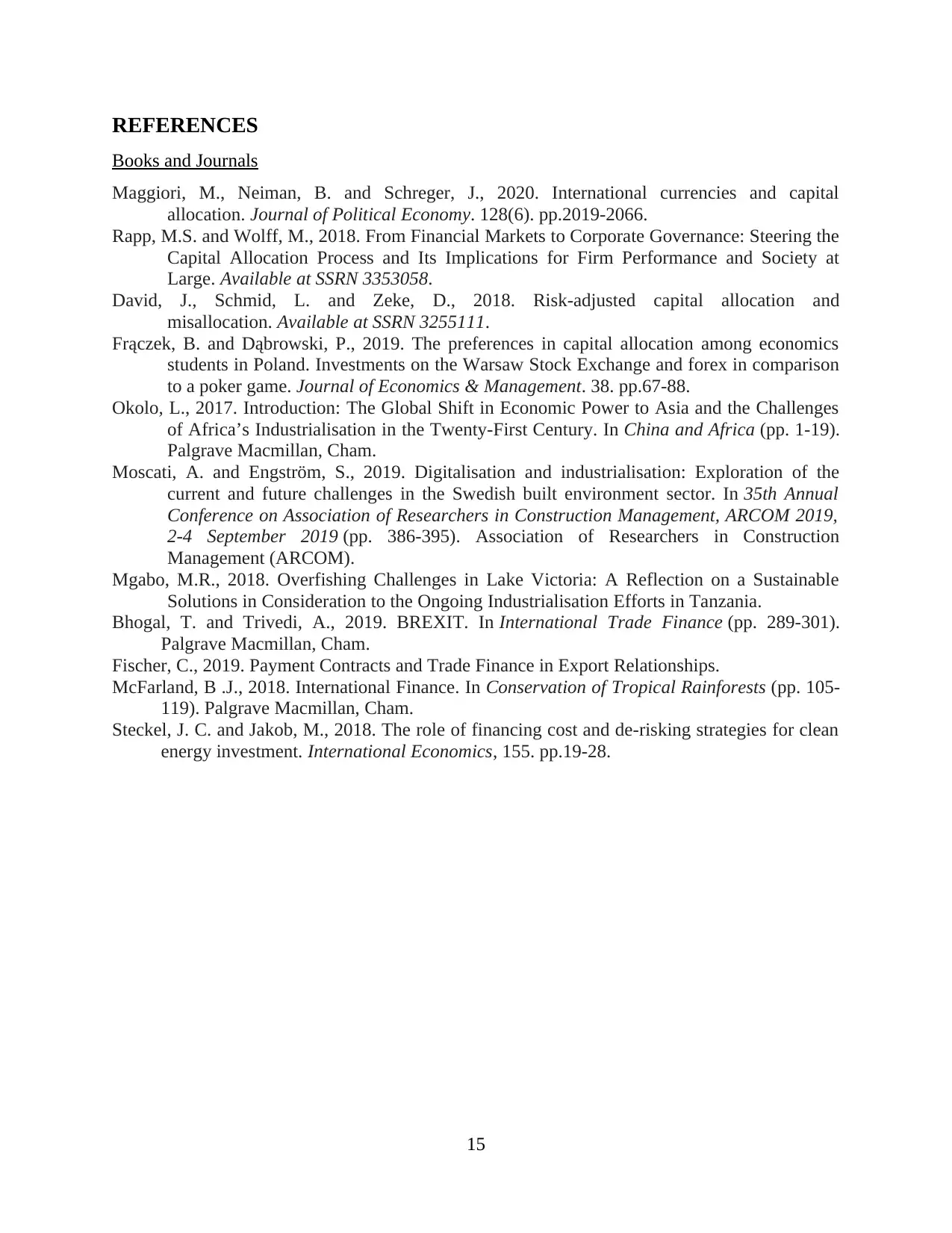
REFERENCES
Books and Journals
Maggiori, M., Neiman, B. and Schreger, J., 2020. International currencies and capital
allocation. Journal of Political Economy. 128(6). pp.2019-2066.
Rapp, M.S. and Wolff, M., 2018. From Financial Markets to Corporate Governance: Steering the
Capital Allocation Process and Its Implications for Firm Performance and Society at
Large. Available at SSRN 3353058.
David, J., Schmid, L. and Zeke, D., 2018. Risk-adjusted capital allocation and
misallocation. Available at SSRN 3255111.
Frączek, B. and Dąbrowski, P., 2019. The preferences in capital allocation among economics
students in Poland. Investments on the Warsaw Stock Exchange and forex in comparison
to a poker game. Journal of Economics & Management. 38. pp.67-88.
Okolo, L., 2017. Introduction: The Global Shift in Economic Power to Asia and the Challenges
of Africa’s Industrialisation in the Twenty-First Century. In China and Africa (pp. 1-19).
Palgrave Macmillan, Cham.
Moscati, A. and Engström, S., 2019. Digitalisation and industrialisation: Exploration of the
current and future challenges in the Swedish built environment sector. In 35th Annual
Conference on Association of Researchers in Construction Management, ARCOM 2019,
2-4 September 2019 (pp. 386-395). Association of Researchers in Construction
Management (ARCOM).
Mgabo, M.R., 2018. Overfishing Challenges in Lake Victoria: A Reflection on a Sustainable
Solutions in Consideration to the Ongoing Industrialisation Efforts in Tanzania.
Bhogal, T. and Trivedi, A., 2019. BREXIT. In International Trade Finance (pp. 289-301).
Palgrave Macmillan, Cham.
Fischer, C., 2019. Payment Contracts and Trade Finance in Export Relationships.
McFarland, B .J., 2018. International Finance. In Conservation of Tropical Rainforests (pp. 105-
119). Palgrave Macmillan, Cham.
Steckel, J. C. and Jakob, M., 2018. The role of financing cost and de-risking strategies for clean
energy investment. International Economics, 155. pp.19-28.
15
Books and Journals
Maggiori, M., Neiman, B. and Schreger, J., 2020. International currencies and capital
allocation. Journal of Political Economy. 128(6). pp.2019-2066.
Rapp, M.S. and Wolff, M., 2018. From Financial Markets to Corporate Governance: Steering the
Capital Allocation Process and Its Implications for Firm Performance and Society at
Large. Available at SSRN 3353058.
David, J., Schmid, L. and Zeke, D., 2018. Risk-adjusted capital allocation and
misallocation. Available at SSRN 3255111.
Frączek, B. and Dąbrowski, P., 2019. The preferences in capital allocation among economics
students in Poland. Investments on the Warsaw Stock Exchange and forex in comparison
to a poker game. Journal of Economics & Management. 38. pp.67-88.
Okolo, L., 2017. Introduction: The Global Shift in Economic Power to Asia and the Challenges
of Africa’s Industrialisation in the Twenty-First Century. In China and Africa (pp. 1-19).
Palgrave Macmillan, Cham.
Moscati, A. and Engström, S., 2019. Digitalisation and industrialisation: Exploration of the
current and future challenges in the Swedish built environment sector. In 35th Annual
Conference on Association of Researchers in Construction Management, ARCOM 2019,
2-4 September 2019 (pp. 386-395). Association of Researchers in Construction
Management (ARCOM).
Mgabo, M.R., 2018. Overfishing Challenges in Lake Victoria: A Reflection on a Sustainable
Solutions in Consideration to the Ongoing Industrialisation Efforts in Tanzania.
Bhogal, T. and Trivedi, A., 2019. BREXIT. In International Trade Finance (pp. 289-301).
Palgrave Macmillan, Cham.
Fischer, C., 2019. Payment Contracts and Trade Finance in Export Relationships.
McFarland, B .J., 2018. International Finance. In Conservation of Tropical Rainforests (pp. 105-
119). Palgrave Macmillan, Cham.
Steckel, J. C. and Jakob, M., 2018. The role of financing cost and de-risking strategies for clean
energy investment. International Economics, 155. pp.19-28.
15
1 out of 17
Related Documents
Your All-in-One AI-Powered Toolkit for Academic Success.
+13062052269
info@desklib.com
Available 24*7 on WhatsApp / Email
![[object Object]](/_next/static/media/star-bottom.7253800d.svg)
Unlock your academic potential
© 2024 | Zucol Services PVT LTD | All rights reserved.



